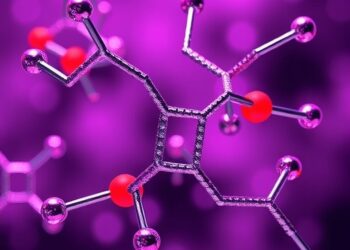Is the quest for the perfect top notes responsible for some of the world’s most influential scientific discoveries? A new article in Isis, a journal of the History of Science Society, argues that fragrance research has stimulated scientific endeavor for over a century, but that its contributions have been overlooked due to perfume’s stigma as a frivolous, feminine luxury. In “Musk and the Making of Macromolecules: Perfumes and Polymers in the History of Organic Chemistry,” author Galina Shyndriayeva demonstrates how tracing the history of perfume production clarifies and enriches the history of chemical innovation and industrial development.
Is the quest for the perfect top notes responsible for some of the world’s most influential scientific discoveries? A new article in Isis, a journal of the History of Science Society, argues that fragrance research has stimulated scientific endeavor for over a century, but that its contributions have been overlooked due to perfume’s stigma as a frivolous, feminine luxury. In “Musk and the Making of Macromolecules: Perfumes and Polymers in the History of Organic Chemistry,” author Galina Shyndriayeva demonstrates how tracing the history of perfume production clarifies and enriches the history of chemical innovation and industrial development.
Leopold Ružička, a recipient of the 1939 Nobel Prize in chemistry, was granted this honor in part due to a discovery he made while working for a Geneva-based perfume supplier: the synthesis of muscone, or artificial musk. Musk, a vital ingredient in the production of perfume, was expensive and time-consuming to source in its natural form, as it involved the hunting of male deer in Russia and the Himalayas region, and the musk pouches of up to fifty bucks were required to generate a single kilogram. Ružička reproduced the substance chemically by identifying a molecular structure involving large rings, defying the prevailing theories of the time regarding atomic composition. The breakthrough was not only of great value to M. Naef, his employer, and the perfume industry at large, but also opened up avenues of other scientific research, “including study of previously unseen arrangements of atoms in space, new ring closure techniques, and identification of other biologically important molecules with a large ring structure, such as oxytocin.”
Ružička’s muscone work and his study of large rings additionally paved the way for further inquiry by American scientist Wallace H. Carothers, a research chemist at the industrial behemoth DuPont. During the First World War, DuPont and other American industries had greatly expanded, and by the late 1920s and early 1930s the company was leveraging this prosperity to diversify its holdings and develop new products. While Carothers was not directly engaged in work with perfume, he and organic chemist Julian W. Hill used Ružička’s large ring findings to inform a new method of polymer synthesis that would ultimately lead to the invention of nylon and polyester. “The codevelopment of knowledge about perfume and polymers,” writes Shyndriayeva, “points to what was driving Ružička’s and Carothers’s research: investigation of some of the most pertinent theoretical questions about chemical structure at the time.”
The unappreciated significance of perfume research reflects, Shyndriayeva notes, a more general disdain for scholarship regarding the “aesthetic-industrial complex.” Some historians—and female historians, in particular—have attempted to correct this imbalance, turning their analysis to “the importance of looks and attractiveness as attributes mobilized for national and political agendas, as essential components for understanding race, class, and gender.” The article argues that the story of perfume is hardly just a frivolous footnote in the history of science—instead intersecting with the legacies of war, molecular structure, and global networks of commerce and development. The study of fragrance and other trivialized subjects could yield a richer, more diverse study of history, and offer up “new paths for reflection.”
Since its inception in 1912, Isis has featured scholarly articles, research notes, and commentary on the history of science, medicine, and technology and their cultural influences. Review essays and book reviews on new contributions to the discipline are also included. An official publication of the History of Science Society, Isis is the oldest English-language journal in the field.
Founded in 1924, the History of Science Society is the world’s largest society dedicated to understanding science, technology, medicine, and their interactions with society in historical context.
Journal
Isis
DOI
Article Title
Musk and the Making of Macromolecules: Perfumes and Polymers in the History of Organic Chemistry




